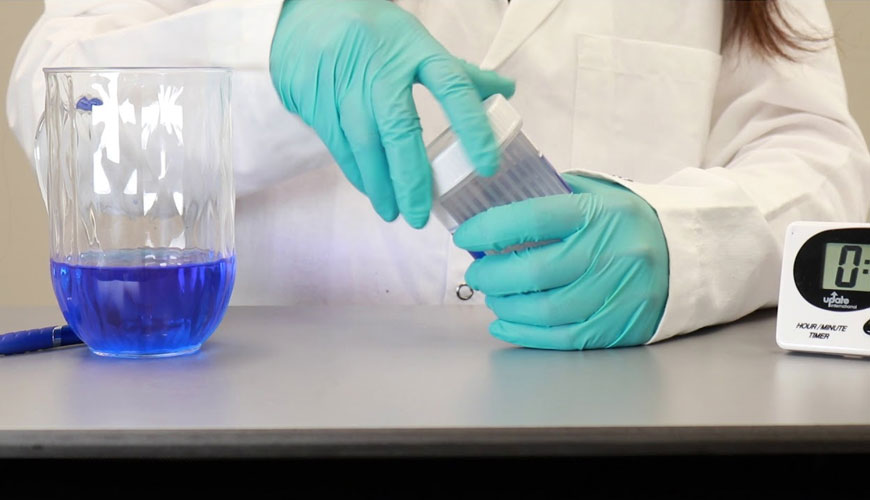

Regarding the MF technique, the coliform group is defined as facultative anaerobic, gram-negative, non-spore-forming, rod-shaped bacteria that develop colonies with distinctive characteristics on specific media. Rarely, on m-Endo medium, typical bright colonies may be produced by non-coliform organisms, and atypical colonies (colonies with pink, crimson, or non-luminous nuclei) may be coliform bacteria; therefore, confirmation of all typical and atypical colonies is recommended.

The MF technique can be used to test drinking, surface, ground, swimming pool and sea waters. Only unless the sample is diluted, as a high turbidity level can quickly clog the membrane filter before sufficient sample is collected.
The MF technique is not used to test wastewater treated with primary treatment.
Straws and graduated cylinders: Before sterilization, graduated cylinders should be loosely capped with metal foil or a suitable heavy wrapping paper substitute. The lid should be fixed immediately after sterilization to prevent contamination.
Containers for culture medium: Clean borosilicate glass bottles are used. Any size or shape of bottles can be used, but erlenmeyer flasks with metal caps, metal foil caps or screw caps ensure adequate mixing of the media and are suitable for storage.
Culture dishes: Sterile borosilicate glass or disposable, pre-sterilized plastic petri dishes are used in 15-60 mm, 9-50 mm or other suitable size. An appropriate number of clean, glass culture dishes should be wrapped in metal foil if dry heat sterilized, or in suitable heavy wrapping paper when autoclaved. Glass and disposable plastic culture dishes with loose lids should be incubated in tightly closed containers to prevent evaporation of moisture resulting in drying out and to provide a moist environment for optimal colony growth.
Filtration units: The filter holding assembly (made of glass, autoclavable plastic, porcelain, stainless steel or disposable plastic) consists of a locking device or a seamless funnel fixed to the base by magnetic force. The design should allow the membrane filter to be held securely on the porous plate of the vessel without mechanical damage and allow all liquid to pass through the membrane during filtration.
The assembly (whole or as individual parts) should be wrapped in heavy wrapping paper or aluminum foil or placed in commercially available autoclave bags, autoclaved sterilized, and stored until use. Alternatively, all surfaces of the previously cleaned and sterilized assembly should be exposed to UV radiation (2 min exposure) for initial sanitization prior to use in the test procedure or before the units are reused in successive series of filtrations. Field units can be sterilized by immersion or spraying with alcohol and then igniting or immersing in boiling water for 2 minutes. Reactive water should be used to avoid hard water deposits. After the unit has been immersed in boiling water, it must be cooled to room temperature before being used again. Sterile, disposable field units may also be used.
For filtration, the housing of the filter holding assembly should be mounted so that a pressure differential (1 to 34 kPa) can be applied over a 51 L filtering bottle with a side tube or other suitable device (the manifold to hold three to six filter assemblies). The bottle must be connected to a vacuum line, an electric vacuum pump, a water pressure-operated filter pump, a hand aspirator, or other means to secure a pressure differential (138 to 207 kPa). A bottle of approximately the same capacity must be connected between the filtering bottle and the vacuum source to capture the carried water.
Membrane filters: Membrane filters with a nominal pore diameter are used to ensure complete retention of coliform bacteria (usually 0,45 m).
Pre-sterilized membrane filters may also be used, preferably where the manufacturer has confirmed that the sterilization technique does not cause toxicity or alter the chemical or physical properties of the membrane. If the membranes have been sterilized in the laboratory, they should be autoclaved at 121°C for 10 minutes. At the end of sterilization, steam should be allowed to escape quickly to minimize the accumulation of condensate on the filters.
Our organization, among numerous test, measurement, analysis and evaluation studies, with its trained and expert staff and advanced technological equipment, within the framework of national and international standards, to demanding healthcare institutions and manufacturers, in accordance with the SM 9222B standard, standard total coliform membrane filter procedure test. provides services.
To get an appointment, to get more detailed information or to request an evaluation, you can ask us to fill in our form and reach you.